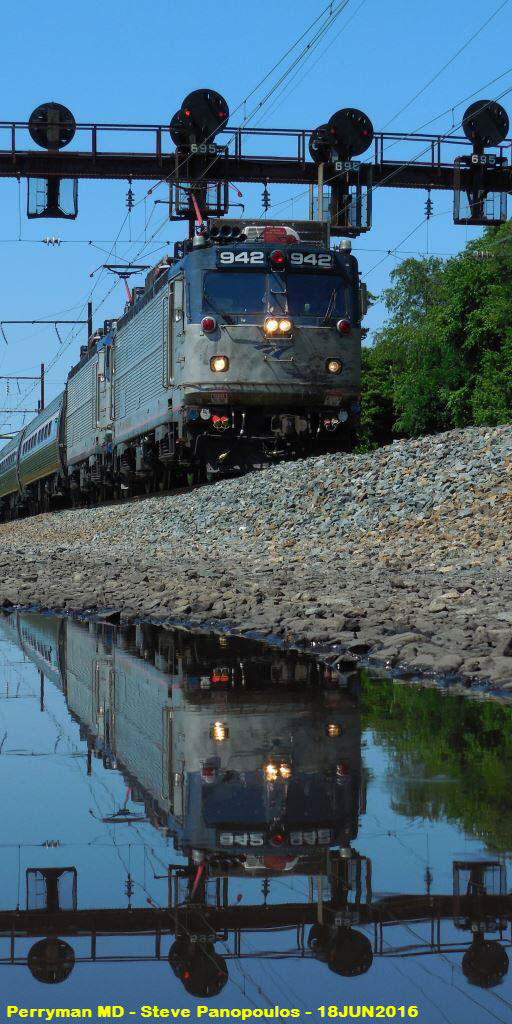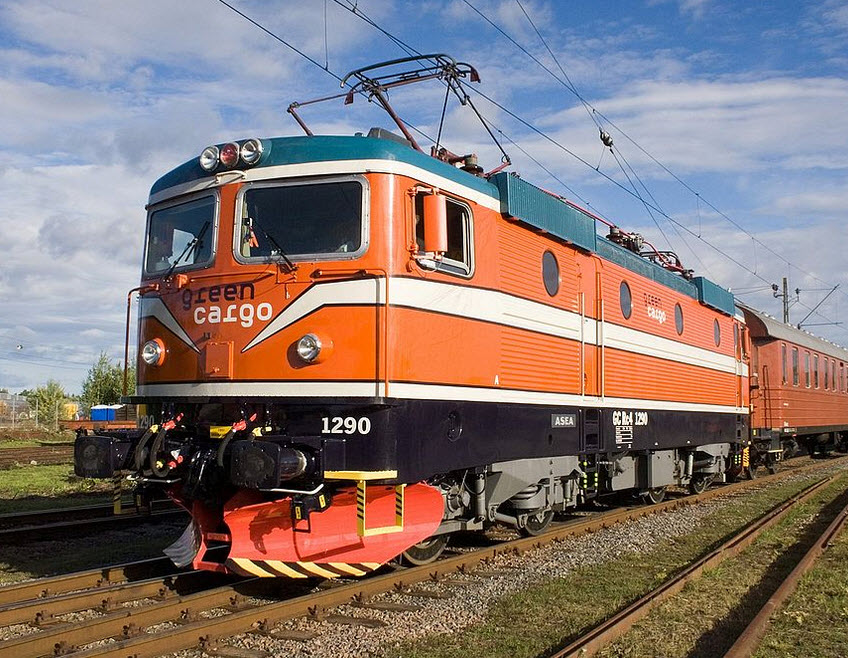RAILFAN GUIDES of the U.S.
Todd's Railfan Guide to
AMTRAK's AEM-7 EXCURSION
A Farewell to the AEM-7
In General
Map
Pictures
History
RAILFAN GUIDES HOME
RAILROAD SIGNALS HOME
Consist Data:
Engines: #942 (Lead) and #95
Cars:
The Scoop:
The
Websites and other additional information sources of interest for the area:
A

All of this comes from Wikipedia and has been edited for content where appropriate
The AEM-7 is a twin-cab B-B electric locomotive that is used in the United States on the Northeast Corridor between Washington DC and Boston and the Keystone Corridor between Philadelphia PA and Harrisburg PA. They were built by GM's Electro-Motive Division (EMD) from 1978 to 1988. EMD manufactured 65 of the locomotives between 1978–1988. The majority of these were for Amtrak, the remainder were for commuter operations on MARC and SEPTA. Amtrak retired their fleet effective June 18th, 2016, in favor of the newer Siemens ACS-64, which entered service in 2014. MARC and SEPTA plan to replace their AEM-7's between 2017–2019.
Amtrak ordered 30 AEM-7s in 1977 (Order Number: 776073) and 17 more in 1980 (Order Number: 806004). By 1978, the Electro-Motive Division of General Motors (EMD), now Electro Motive Diesel, began production. The bodies came from the Budd Company, with electrical, trucks and mechanical parts imported from Sweden. The first AEM-7 (900) went into service in 1979. The Swedish influence led to the nickname " Meatball", after Swedish meatballs. Railfans nicknamed the boxy locomotives "toasters." Between 1980 and 1982, 46 AEM-7s (900-946) went into service. This helped retire the GG1s from regular service. Amtrak ordered seven more AEM-7s in 1987 (Order Number: 876006), which were completed by 1988. Two commuter operators in the Northeast ordered AEM-7s. MARC ordered four in 1986 for use on its Penn Line service on the Northeast Corridor between Washington, D.C. and Perryville MD. SEPTA ordered seven in 1987.
In 2010 Amtrak ordered 70 Siemens ACS-64 locomotives to replace both the AEM-7s and the newer but unreliable Bombardier/Alstom HHP-8s. The ACS-64s began entering revenue service in February 2014. The last two AEM-7s owned by Amtrak made their final run on June 18, 2016 on a special excursion that ran between Washington, DC and Philadelphia.
MARC ordered the Siemens Charger locomotive to replace their fleet of AEM-7s and HHP-8s. Replacement is expected between 2017 and 2018.
SEPTA will replace their AEM-7s and single ALP-44 with the ACS-64 between 2018 and 2019.
Background: Amtrak had inherited high-speed operations on the Northeast Corridor from the bankrupt Penn Central in 1971. Electrified passenger services between New York and Washington were handled by the new if unreliable Budd Metroliner electric multiple units and the aging PRR GG1s, originally built for the Pennsylvania Railroad in 1934–1943. Amtrak's first attempt at replacing the GG1 was the General Electric E60, delivered in 1974. The E60s proved unable to safely exceed 100 miles per hour (160 km/h) because of tracking problems with the trucks, and Amtrak relegated them to hauling slower long-distance services. Amtrak turned to existing European high-speed designs, and two were brought over for trials in 1976–77: the Swedish Rc4 (numbered X995), and the French CC 21000 (X996). Amtrak favored the Swedish design, which became the basis for the AEM-7.
 David Gubler - Sep 8, 2006
David Gubler - Sep 8, 2006An Rc4 owned by Green Cargo in its original livery as it has been used by SJ. The picture was taken on the yard of the Swedish railway museum at Gävle, during the Tag150 festivities.
Design: The AEM-7 weighs 101 short tons (90 long tons; 92 t), whereas the GG1 weighs 238 short tons (213 long tons; 216 t). With all the weight on eight drivers, the AEM-7 has a high horsepower to weight ratio (70 hp/short ton) and needs a sophisticated wheelslip control (Pressductor) system.
The locomotive's head end power (HEP) was sufficient for 8-10 Amfleet cars.
The AEM-7AC: In 1999, Amtrak and Alstom began a remanufacturing program for Amtrak AEM-7s. Alstom supplied AC propulsion equipment, electrical cabinets, transformers, HEP, and cab displays. The rebuild provided Amtrak with locomotives that had improved high end tractive effort and performance with longer trains. Amtrak workers performed the overhauls under Alstom supervision at Amtrak's shop in Wilmington DE. These remanufactured AEM-7s are designated as "AEM-7AC"s. Between 1999 and 2002, 29 AEM-7s were converted to AEM-7ACs.
The power modules use water-cooled IGBT (Insulated Gate, Bipolar Transistor) technology and provide about 5,000 kilowatts (6,700 horsepower) of traction power plus 1,000 kilowatts (1,300 horsepower) of HEP, an improvement over the 500 kilowatts (670 horsepower) HEP capacity of the original DC units, and enough for 18 Amfleet or Viewliner coaches. The traction motors (model 6 FXA 5856) are from Alstom's ONIX family of propulsion components, and have a maximum rating of 1,250 kilowatts (1,680 horsepower) - 1,275 kilowatts (1,710 horsepower) and a continuous rating of 1,080 kilowatts (1,450 horsepower). Locomotive electric brake ratings are ~4,300 kilowatts (5,800 horsepower) in regenerative mode and ~2,200 kilowatts (3,000 horsepower) in rheostatic (resistor-only) mode. As such, the remanufactured AEM-7 was the world's first passenger locomotive with IGBT in service.
Sideline: the ALP-44: The ABB ALP-44 is an electric locomotive built by ASEA Brown Boveri (Sweden) between 1990 and 1996. It was designed specifically for New Jersey Transit. At first glance, the two locomotives might look the same to a casual observer, but if one looks closely, they will be able to spot the differences. Both the ALP-44 and AEM-7 are based on the same line of locomotives from ABB; the AEM-7 from the Rc4, and the ALP-44 from the Rc6 and Rc7 models. ABB provided one ALP-44 to SEPTA in part settlement of claims for late delivery of the N-5 Norristown High Speed Line cars. The engine (numbered 2308) operates interchangeably with SEPTA's AEM-7 fleet. SEPTA'S AEM-7 and ALP-44 fleet will be retired and replaced by the ACS-64 by 2018-2019. NJ Transit has since retired its fleet of ALP-44s.
NEW 06/19/2016
Last Modified
19-Jun-2016